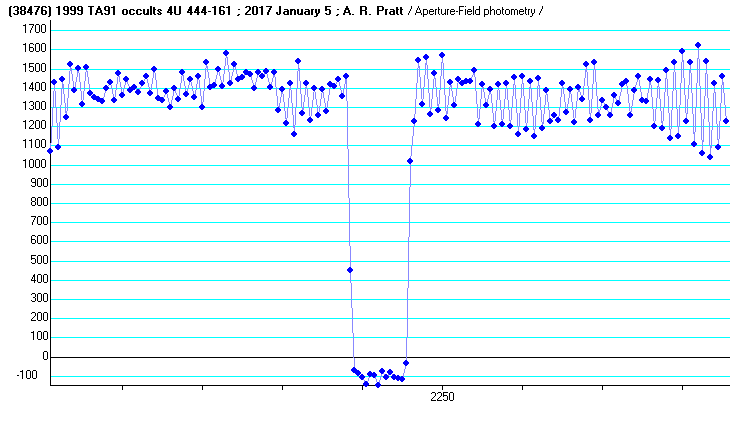Observation by Alex Pratt: Asteroid (38476) 1999 TA91 occulting sta...
Uploaded by
Alex Pratt
Observer
Alex Pratt
Observed
2017 Jan 05 - 17:42
Uploaded
2017 Jan 22 - 23:33
Objects
Conjunction
Planetarium overlay
Constellation
Virgo
Field centre
RA: 13h13m
Dec: -01°47'
Position angle: +89°52'
Field size
0°08' × 0°05'
Equipment
- C11 and f/3.3 focal reducer
- Watec 910 video camera
- IOTA-VTI GPS time inserter
Exposure
1/50th sec (0.02sec exposures)
Location
Z92
Target name
Asteroid (38476) 1999 TA91 and star 4U 444-161
Title
Asteroid (38476) 1999 TA91 occulting star 4U 444-161
About this image
The mag 20 asteroid (38476) 1999 TA91 was predicted to occult the mag 8.6 star 4U 444-161 on 2017 January 5 at 17:42:25 UT +/- 5s, as seen from my location. The asteroid is small, producing a ground track shadow only 8km in diameter, and the maximum duration of the occultation would be 0.3s with a probability of success of about 2%.
The star is bright, so the Watec camera was set to run at 50 fields per second, 0.02s exposures. I was most fortunate to record the target star blink out for 0.3s as it was covered by the asteroid (see the light curve created using Limovie). I must have been on the centreline of the ground track. A short extract of the video is currently available on the BAA ARPS website.
The reduced timings are:-
17:42:22.54 +/- 0.02s Disappearance
17:42:22.84 +/- 0.01s Reappearance
Multiple observations of occultations by larger asteroids produce chords across the ground shadow of the body, allowing us to create a shape profile of the asteroid.
Accurate timings of asteroidal occultations also give an astrometric measurement of the position of the asteroid, of particular value now that Gaia is delivering a star catalogue of unprecedented accuracy.
Files associated with this observation
Like this image
David Basey,
Jeremy Shears,
Gary Poyner,
Denis Buczynski,
David Conner,
Mr Leonard Entwisle,
Dawson,
Peter Carson,
Tom Moran,
Mike Foylan,
Dr Paul Leyland
Comments
A fine result for such a small asteroid. Congratulations...
Thanks Tim.
It's nice to record one of these low probability occultations after so many negative results. Let's hope 2017 brings us clear skies to obtain multi-chord observations of wide track events across the British Isles.
Well done Alex on this rare achievement: being in the shadow of a tiny 7km object as seen from 406 million km away. Eventually when the Gaia data reaches fruition in about 5 year's time, observations of this kind will be able to be targeted with much greater certainty and so hopefully it will be possible to obtain chords from several observers. You never know, this one might have been a binary system.
Copyright of all images and other observations submitted to the BAA remains with the owner of the work.
Reproduction of work by third parties is expressly forbidden without the consent of the copyright
holder. By submitting images to this online gallery, you grant the BAA permission to reproduce them in
any
of our publications.


